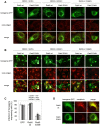Differential requirements in endocytic trafficking for penetration of dengue virus
- PMID: 22970315
- PMCID: PMC3436767
- DOI: 10.1371/journal.pone.0044835
Differential requirements in endocytic trafficking for penetration of dengue virus
Abstract
The entry of DENV into the host cell appears to be a very complex process which has been started to be studied in detail. In this report, the route of functional intracellular trafficking after endocytic uptake of dengue virus serotype 1 (DENV-1) strain HW, DENV-2 strain NGC and DENV-2 strain 16681 into Vero cells was studied by using a susceptibility to ammonium chloride assay, dominant negative mutants of several members of the family of cellular Rab GTPases that participate in regulation of transport through endosome vesicles and immunofluorescence colocalization. Together, the results presented demonstrate that in spite of the different internalization route among viral serotypes in Vero cells and regardless of the viral strain, DENV particles are first transported to early endosomes in a Rab5-dependent manner. Then a Rab7-dependent pathway guides DENV-2 16681 to late endosomes, whereas a yet unknown sorting event controls the transport of DENV-2 NGC, and most probably DENV-1 HW, to the perinuclear recycling compartments where fusion membrane would take place releasing nucleocapsid into the cytoplasm. Besides the demonstration of a different intracellular trafficking for two DENV-2 strains that shared the initial clathrin-independent internalization route, these studies proved for the first time the involvement of the slow recycling pathway for DENV-2 productive infection.
Conflict of interest statement
Figures







Similar articles
-
Dengue-3 Virus Entry into Vero Cells: Role of Clathrin-Mediated Endocytosis in the Outcome of Infection.PLoS One. 2015 Oct 15;10(10):e0140824. doi: 10.1371/journal.pone.0140824. eCollection 2015. PLoS One. 2015. PMID: 26469784 Free PMC article.
-
Dissecting the cell entry pathway of dengue virus by single-particle tracking in living cells.PLoS Pathog. 2008 Dec;4(12):e1000244. doi: 10.1371/journal.ppat.1000244. Epub 2008 Dec 19. PLoS Pathog. 2008. PMID: 19096510 Free PMC article.
-
Functional entry of dengue virus into Aedes albopictus mosquito cells is dependent on clathrin-mediated endocytosis.J Gen Virol. 2008 Feb;89(Pt 2):474-484. doi: 10.1099/vir.0.83357-0. J Gen Virol. 2008. PMID: 18198378
-
Alternative infectious entry pathways for dengue virus serotypes into mammalian cells.Cell Microbiol. 2009 Oct;11(10):1533-49. doi: 10.1111/j.1462-5822.2009.01345.x. Epub 2009 Jun 11. Cell Microbiol. 2009. PMID: 19523154 Free PMC article.
-
Role of angiotensin II in cellular entry and replication of dengue virus.Arch Virol. 2024 May 16;169(6):121. doi: 10.1007/s00705-024-06040-4. Arch Virol. 2024. PMID: 38753119 Review.
Cited by
-
Characterization of Zika Virus Endocytic Pathways in Human Glioblastoma Cells.Front Microbiol. 2020 Mar 6;11:242. doi: 10.3389/fmicb.2020.00242. eCollection 2020. Front Microbiol. 2020. PMID: 32210929 Free PMC article.
-
Blockade of dengue virus entry into myeloid cells by endocytic inhibitors in the presence or absence of antibodies.PLoS Negl Trop Dis. 2018 Aug 9;12(8):e0006685. doi: 10.1371/journal.pntd.0006685. eCollection 2018 Aug. PLoS Negl Trop Dis. 2018. PMID: 30092029 Free PMC article.
-
Evaluation of the relationship between the 14-3-3ε protein and LvRab11 in the shrimp Litopenaeus vannamei during WSSV infection.Sci Rep. 2021 Sep 28;11(1):19188. doi: 10.1038/s41598-021-97828-w. Sci Rep. 2021. PMID: 34584112 Free PMC article.
-
Entry of Classical Swine Fever Virus into PK-15 Cells via a pH-, Dynamin-, and Cholesterol-Dependent, Clathrin-Mediated Endocytic Pathway That Requires Rab5 and Rab7.J Virol. 2016 Sep 29;90(20):9194-208. doi: 10.1128/JVI.00688-16. Print 2016 Oct 15. J Virol. 2016. PMID: 27489278 Free PMC article.
-
Role of autophagy during the replication and pathogenesis of common mosquito-borne flavi- and alphaviruses.Open Biol. 2019 Mar 29;9(3):190009. doi: 10.1098/rsob.190009. Open Biol. 2019. PMID: 30862253 Free PMC article. Review.
References
Publication types
MeSH terms
Substances
LinkOut - more resources
Full Text Sources

